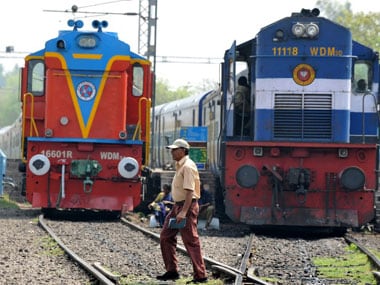New Delhi: The Indian Railways boasts of large network of trains and employees lakhs of people. But when it comes to speed and efficiency Indian Railways lags far behind in comparison to other developed nations, barring a few semi-high speed trains the average speed of trains in India is 54 km/ph.
[caption id=“attachment_1608729” align=“alignleft” width=“380”] Representational image. AFP[/caption]
Representational image. AFP[/caption]
As a consequence to slow speed trains, people travelling long distances spends days on the train. The trains nearing an average speed of 55 km per hour are dubbed ‘superfast’ while the one touching a speed of 70 km per hour are termed ‘premium’ trains. These figures give us a picture of Indian Railways standing in comparison to neighbour China and other countries like Japan, France and Germany.
This raises the pertinent question about the slow speed of Indian trains, one of the major reasons being that the trains cannot travel at its optimum speed. Traffic congestion, weak infrastructure, the design of the trains is some of the reasons which pose as a huge hindrance to the speed of the trains.
If the details are looked at, the Indian railways is equipped with train engines that can travel at a speed of 160 km per hour, but due to old coach designs, the maximum speed they can travel at is 110-110 km per hour. Here is a look at some of the main reasons for the inefficiency in railways:
1. Heavy congestion on the railway track
The biggest challenge that railways faces is the insufficient number of tracks and large number of trains, on most occasions the trains cannot travel at its optimum speed because they do not get clearances on time. The high-speed trains like Rajdhani and Shatabdi are given preference over normal trains and thus most of the times when these trains are passing through a single track line the normal trains have to wait for hours to get a clearance.
2. Ground reality
The express trains are stopped when a passenger train is travelling ahead of it. It is only after the passengers have de-boarded at the station and the passenger train has left the station does the express train get clearance. In this scenario, even if the halt time of the train is 2 minutes it is increased to 15 minutes.
3. Weak infrastructure
In India, the main line tracks built cannot even sustain the trains travelling at a speed of 110-130 km per hour. Due to this, the average speed of the trains is hampered. The time required to travel is increased because of weak infrastructure. The other old lines have worn off over a period of time and thus the trains that are already behind schedule have to face further problems on these tracks. Other major hindrance is the insufficient number of platforms, the trains usually wait on the tracks for a long period of time due to lack of platforms. Another hindrance is the terrain which does not have a straight track thus slowing down the speed of the train.
4. Design of the train
The designs of the train hinder in speeding up, the open doors and windows and the heavy rail coaches slow down trains, the old chain and buffer coupling system is also a major roadblock. While in most parts of the world modern railway system- EMU is in place which enhances the speed while travelling long distances. The motor power wheel coaches are being built by other countries to boost the speed.
5. Regulation on speed
Temporary Speed Restrictions and permanent speed restrictions slow down the train. When the train approaches and crosses a station the train is suppose to run at a speed of 30 km per hour. While TSR is imposed when the tracks are broken or being repaired or the maintenance work is on. Meanwhile the PSR is imposed while the train is crossing a ghat region or a hill region and a populated city. These limitations and restrictions are one of the few causes of slow trains.
6. Timetable of the trains
The timetable of the trains can alter the speed of the train, the time taken to cover a stipulated distance can be calculated with the preparation of the schedule of the trains. In most countries the speed of the train is set as per the distance the train has to travel but it is not the same with Indian railways, the average speed is based on the number of trains passing on the track, railway congestion makes a huge difference to the speed of the train.
PTI
)